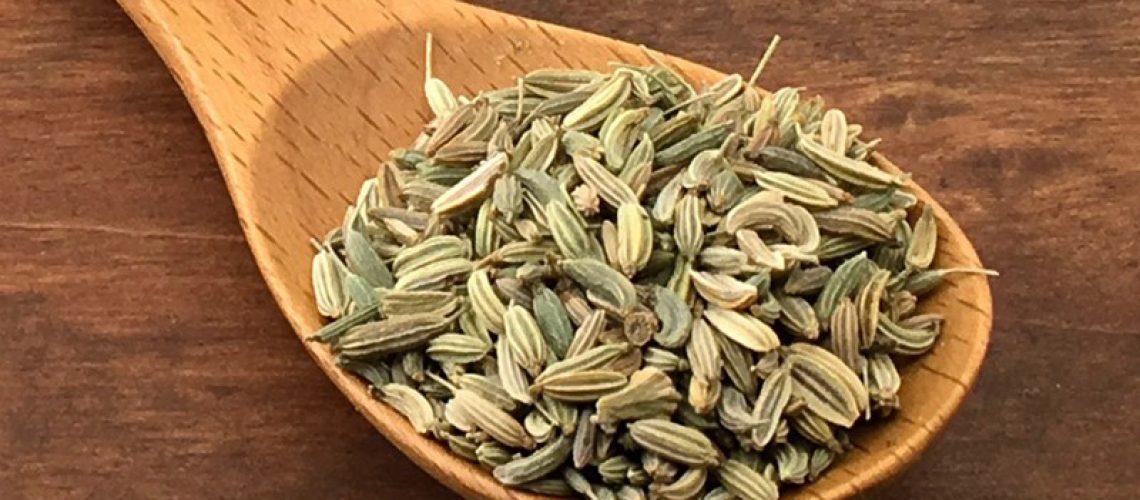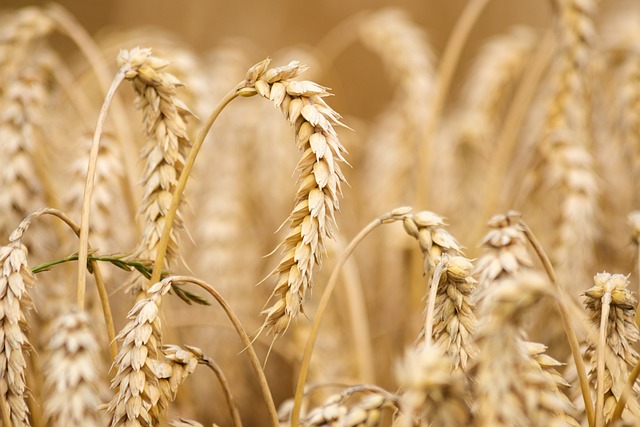We call them ‘fennel seeds,’ but we make a mistake because they are actually achenes, the dried ‘fruit’ of the plant that contains a single seed inside. This highly fragrant spice, which is reminiscent of the taste of aniseed, is valued for culinary use, but also in herbal medicine for the preparation of decoctions, infusions and herbal teas, which have certain therapeutic benefits that have been known since ancient times. So let’s find out about them!
In Botany. Fennel is known as Foeniculum vulgare: it is a perennial herbaceous plant in the umbelliferous family, more specifically the Apiaceae. It has whitish roots and light green branched stems that can reach up to 1.5 meters in height. The leaves are divided into very thin, yellowish-green laciniae, while the flowers are composed of tiny yellow petals gathered into umbels (hence the term umbelliferous). The inflorescences appear between July-August, while the fruit-the achene-is elongated, green to whitish in color depending on the stage of ripening. Of fennel one uses both the fresh leaves, which resemble hay and are harvested in spring, and the seeds, which instead can be harvested from mid-August to late September. These are 4-8 mm long, thin and slightly curved, dark greenish-yellow in color, with an aromatic, sweet anise-like odor and flavor, although milder. Finally, the fruits are harvested from August to November. However, if we move to Greece, in its ancient civilization, Foeniculum vulgare was called Marathon, a name that could derive either from the region of Attica where this plant grew widely, or from the Olympic discipline of marathon running. In fact, according to an ancient Greek legend, the Athenian soldier Pheidippides ran across the 42-kilometer-long Marathon field to announce to his fellow citizens his victory over the Spartans; it is no coincidence that the Olympic marathon is still run today over precisely this distance. While in ancient Rome, fennel seed symbolized strength: gladiators before entering the arena ate copious handfuls of it to invigorate themselves.
Habitat. Fennel grows in the Mediterranean basin, from coastal areas to uncultivated meadows up to 1,000 meters above sea level. There are two varieties: wild fennel, a wild, perennial plant with a branched stem that reaches 2 m in height, and cultivated fennel, an annual or biennial plant that reaches 60-80 cm in height. Today the main fennel-producing countries are: India, Mexico, China and Iran, while the major user countries are Northern Europe and the Middle and Far East.
Between history and popular belief. The first cultivation of wild fennel can be traced back to the 16th century, and it is perhaps little known that the popular term ‘infinocchiare,’ meaning “to cheat,” is derived from this plant; in fact, fennel was used to deceive the customer’s taste about the poor quality of wine or to alter the taste of bottled wine. Knowledge of fennel is ancient, however, and we have already given you a hint of it relative to the name, but not only: Demosthenes, an Athenian politician and orator in the third century B.C., reports the use of fennel wreaths for ritual to Dionysius, while it was the Romans who spread it to Continental Europe. Pliny the Elder, in the 1st century AD, tells instead that snakes rubbed against the fennel plant after changing their skin to regain their eyesight, so much so that fennel has since been considered an eye care remedy. Ancient folk beliefs hold it to be a powerful antidote against the biting of venomous reptiles and dogs, and again according to folk tradition, the animals themselves would use wild fennel ‘therapeutically’: dogs and cats to generically cure their own ailments, horses to remedy snake bites, and tortoise to recover their sight. While in the Middle Ages, bunches of fennel were hung over the front doors of houses to keep spirits away or seeds were placed in keyholes for the same reason especially on the night of the Midsummer Festival. Again: in the court of King Edward I of England, quantities of fennel seeds were consumed, roughly 2 kilograms per month, both as a seasoning to flavor dishes and as a hunger suppressant, and with this same meaning, according to a tradition introduced by the Puritans in Europe, it was customary to go to church with handkerchiefs wrapped around seeds to chew away hunger, during long religious ceremonies.
Uses in cooking. Small, intensely fragrant and highly aromatic in shape similar to cumin, fennel seeds, which are very versatile, are widely used in cooking in sweet and savory recipes, used whole, ground or powdered. Of the “finocchina” or “fennel,” as it is called in cuciuna, both fresh or dried flowers are used, as well as the seeds, which are more or less sweet, peppery or bitter, depending on the variety, as are the leaves (or “beard”) and twigs. Here’s where to use fennel:
- Breads and baked goods: in the dough of crackers, breadsticks, taralli, and breads can be inserted or seeds to enrich their taste or can be sprinkled on the surface of bread or other preparations, such as prezels, or for decorative purposes on canapés and bruschetta.
- Vegetables: seeds are great to add to stir-fried vegetables to give a spicy taste and thus also reduce salt intake given the intense flavor. The fresh, shredded leaves, on the other hand, can be used to flavor salads as well as soups and cheeses.
- Meat and fish: many meat preparations, such as porchetta or other pork, sausages and salami including Tuscan finocchiona, or fish can be enriched and flavored with fennel seeds.
- Eggs: even omelets and omelettes will turn out better and more distinctive with the addition of fennel seeds.
- Sauces and ragouts: seeds give flavor even to simple tomato sauce as well as to those enriched with meat and/or vegetables.
- Sweets: their use is less exploited, but the seeds also lend themselves to the preparation of sweet or savory muffins, flavored ice creams, cakes and spiced cookies.
- Regional recipes: fennel seeds are essential ingredients for cooking bombetti, sea snails, a typical dish of the Marche region, or for tanning salted olives with chili and garlic. While the leaves of the wild fennel are essential for Sicilian pasta with sardines and for finocchino, a typical cookie from Piedmont.
- Beverages: among the best-known and most popular is fennel herbal tea, a refreshing, deflating and diuretic summer drink that can be paired with other herbs, such as mint, to make it even tastier and perfect for coping with the heat, or even bay leaf and pepper. In addition, fennel seeds lend themselves to the preparation of digestive decoctions, liqueurs, and aromatic bitters such as gin, absinthe, and some brandies. These include a “fennel liqueur,” typical of the coastal regions of the Tyrrhenian Sea, in the preparation of which the fresh flowers and/or seeds and leaves are used.
- Abroad: fennel seeds make up the French blend Herbs de Provence as well or the Chinese blend Five Spices and Indian Punch phoron, in England they are added to court-bouillon to boil fish.
The seeds can be added to dishes ‘au naturel’ or they can be roasted, lightening the flavor, which becomes more aromatic and less sweet. They can be pounded in a mortar or be replaced by anise seeds, using less than indicated in the recipe.
Cultivation of (seed of) fennel. It is not among the easiest herbs to grow in the garden, but it can be done, with some care starting with planting and soil type.
- Before sowing: it is necessary to prepare the soil, with thorough deep digging. In fact, the fennel plant does not like soils that are too compact, because they hinder the swelling of the base, so clay soils should be avoided, adding sand if necessary. Care should be taken that the garden soil is draining: any stagnation will cause the lumps to rot. As for fertilization, at the time of soil preparation, a couple of weeks before planting, it is good to use mature manure or compost, while pelleted manure can be used in the process by hoeing it into the soil near the plant.
- When to sow. The fennel seed is tiny and very sensitive to severe cold but especially to excessive heat, which can cause early flowering, irreparably ruining the crop. Therefore, it is advisable to start seeding-direct or seed-starting-from June until September. In the case of the seedbed,it is possible to start with the first stage from March, always paying attention to the temperatures,which should never fall below 7 degrees or exceed 20 degrees. So, in general, the best time to sow fennel is summer: starting in June until September, it can be put in seedbeds, or directly planted in the vegetable garden, as long as the seedling is not overly exposed to summer heat. Although in some climate zones fennel can also be grown by sowing it in March, it remains more common as a winter vegetable.
- Fundamental is the moon: that’s right depending on how much you want to get out of the plant you need to take into consideration the phases of the moon. In fact, according to peasant tradition, the waxing phase causes the aerial part of the plant, i.e., stem, leaves, and flowering, to develop, while the waning moon favors bulbs and roots.
How to sow fennel. It is possible to proceed in three ways:
- in pots: this is not a usual practice because the umbellifer needs a lot of space to grow healthy. However, should you wish to proceed, it is necessary to obtain a rather large and deep pot (at least 30 cm), at the bottom of which to place gravel or stones to promote liquid drainage.
- in the open field: no planting depth is required, simply bury the seeds one and a half centimeters above the surface, previously setting the planting sixth that will also determine the final shape of the vegetable. That is, the vegetable may be round in case of dilated spaces between seedlings, or more elongated in shape if the crops are close together. In general, seedlings should be at least 30 cm apart in rows spaced at least 50/70 cm apart.
- Direct sowing: seedlings should be placed about 1-2 cm deep and thinned later. In case it is necessary to transplant germinated crops in the seedbed, this should be done when the seedlings have reached at least 10 cm in height, providing a minimum distance between fennel seedlings of at least 25 cm.
Germination. It is rather slow: fennel seeds are very small, more than 150 seeds are counted in one gram, and it will take about 2-3 weeks after planting before you see anything ‘sprout’. Fennel planting can be started in spring by using the evergreen seedbed. For example, it is possible to place 2-3 seeds of the umbellifer in each pot by resorting to warm-bed sowing in case of winter sowing (December to March).
Maturation. The time it takes the fennel plant to be ready for harvest depends on the variety sown: some cultivars are late and some are earlier. Generally, fennels have a cycle of 100/150 days from the time of planting
Collection. In Italy, harvesting of the wild fennel flower takes place as soon as the flower is “open,” thus starting from mid-August until late September. The flower can be used fresh or once it has been dried outdoors in the light, but away from direct sunlight, which would evaporate the essential oils. Diachenes can be harvested in early autumn, when the transformation of flower to fruit has occurred. The “barbs” or leaves and tender shoots can be harvested from spring to late autumn
***
Conservation. Fennel seeds should be stored out of direct sunlight and away from heat sources, in a cool, dry place and if possible inside airtight glass jars: this is the only way they will keep their characteristic aroma intact for several months. Fennel seeds can be propagated and saved from year to year by gardeners, letting one plant make it to flowering. Fennel seeds on average keep for three years; if they are older, it is likely that they will not germinate. Fennel seeds alternatively can be purchased online or in specialty stores.




















































































